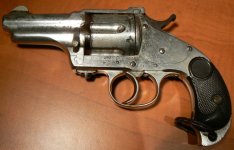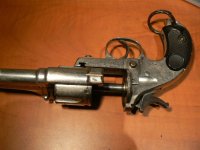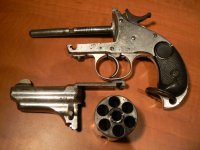Hello everyone, this is my first posting on the site . I am from South Africa and was given a revolver around 1972 when I was a kid by an old lady who's father was a Boer soldier in the 1899-1902 Boer War. She told me her father took this from a captured British Soldier.
. I am from South Africa and was given a revolver around 1972 when I was a kid by an old lady who's father was a Boer soldier in the 1899-1902 Boer War. She told me her father took this from a captured British Soldier.
This arm was registered as a relic and thus no licence was necessary. All these years while the gun was in my posession I really never bothered about it until I discovered your site and saw an opportunity to try and match this item with history.
1) Can someone help me with the ID, was this a common handgun in US or is it quite a rare item?
2) Did the US supply the British Army with handguns in the time of the Boer War, as I understand the Brits standard handgun then was the Webly and Scott mark 4.
3) I read there were US observers in South Africa on both the Boer and British sides, maybe this is where it comes from?
4) Another possibility is that a British officer obtained this arm in his private capacity and took it along to war?(Young Winston Churchill was an officer in the Boer War and there is a famous picture of him with a mauser pistol)
Attached the 3 pictures:
The large ring on the bottom of the butt maybe indicating it as a military item?
The pictures show the unique way of assembling this gun.
3 groups of wording:
a) CALIBRE winchester 1873
b) MERWIN HULBERT & CO. N.Y.
POCKET ARMY
c) written on the barrel
HOPKINS AND ALLEN???? NORWICH,CONN, U.S.A.
PAT. APR 7.77 JUNE 15.80 MAR 14.82 JAN 9.88
d) ser no. 421
thanks
boertjie
This arm was registered as a relic and thus no licence was necessary. All these years while the gun was in my posession I really never bothered about it until I discovered your site and saw an opportunity to try and match this item with history.
1) Can someone help me with the ID, was this a common handgun in US or is it quite a rare item?
2) Did the US supply the British Army with handguns in the time of the Boer War, as I understand the Brits standard handgun then was the Webly and Scott mark 4.
3) I read there were US observers in South Africa on both the Boer and British sides, maybe this is where it comes from?
4) Another possibility is that a British officer obtained this arm in his private capacity and took it along to war?(Young Winston Churchill was an officer in the Boer War and there is a famous picture of him with a mauser pistol)
Attached the 3 pictures:
The large ring on the bottom of the butt maybe indicating it as a military item?
The pictures show the unique way of assembling this gun.
3 groups of wording:
a) CALIBRE winchester 1873
b) MERWIN HULBERT & CO. N.Y.
POCKET ARMY
c) written on the barrel
HOPKINS AND ALLEN???? NORWICH,CONN, U.S.A.
PAT. APR 7.77 JUNE 15.80 MAR 14.82 JAN 9.88
d) ser no. 421
thanks
boertjie
Attachments
Last edited:



